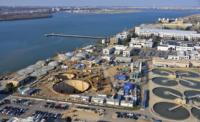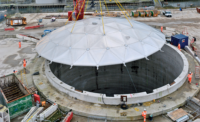Best of the Best 2016
Project of the Year - Blue Plains Tunnel

The Potomac River, Anacostia River and Rock Creek move water through the Washington, D.C., watershed. All three feeder streams are prone to combined-sewer overflows during storms, but the slow-moving Anacostia is the most critical: It receives 66% of the volumetric overflow. Four of five EPA-mandated tunnels address combined-sewer overflows in the Anacostia basin, with a reduction goal of 98%.
COURTESY OF TRAYLOR, SKANSKA, JAY DEE JOINT VENTURE

Cutter head helped custom-built TBM to bore 150 ft on its best day.
COURTESY OF DC WATER

Access shaft is 165 ft deep.
COURTESY OF DC WATER

DC Water GM George S. Hawkins believes the Clean Rivers Project will bring Washington, D.C., into Clean Water Act compliance.
COURTESY OF DC WATER

Placement of 1,300-ton TBM, dubbed “Lady Bird,” required a heavy-duty jib crane. The fully assembled machine was 400 ft long.
PHOTO BY TED COYLE

The Blue Plains tunnel, stretching 4.5 miles adjacent to the Potomac and Anacostia rivers, is designed to capture 98% of the wet-weather volume from combined-sewer overflow.
PHOTO COURTESY OF D.C. WATER

Green infrastructure measures enabled DC Water to eliminate the Rock Creek tunnel.
COURTESY OF D.C. WATER







Blue Plains Tunnel
Washington, D.C.
Region MidAtlantic
Project of the Year
Project Team
Owner DC Water
Lead Design/Structural Engineer/Engineer of Record CH2M
General Contractor Traylor, Skanska, Jay Dee Joint Venture (TSJD)
Hydraulics and Program Management Greeley and Hansen
Geotechnical Engineer McMillen Jacobs Associates
Construction Manager EPC Consultants
Electrical Leyden Electric
Slurry Wall Bencor Corp. of America
Rebar Bulldog Construction
Precast Tunnel Segments ConSeg JV/Bay State Precast
Instrumentation EMC2 Engineers
TBM Fabricator Herrenknecht Tunneling Systems
Environmental Controls Kroner Environmental Services Inc.
Waterproofing WISKO America Inc.
Long before Donald Trump promised to “drain the swamp” in Washington, the U.S. Environmental Protection Agency issued a set of very detailed directions for ending the persistent flooding of the District of the Columbia’s 61-square-mile watershed from the city’s combined-sewer overflow system. George S. Hawkins, general manager of the District of Columbia Water and Sewer Authority, explains the challenge wryly and succinctly, saying, “We have about 3 billion gallons of water that gets away from our sewer system in a wet-weather year.”
Unlike Trump’s promises, which so far have lacked specific details or even consensus as to their meaning, the U.S. Environmental Protection Agency’s 2005 consent decree clearly delineates the steps DC Water must take to bring the city into Clean Water Act compliance. Several years into the program, DC Water is on track, meeting the decree’s schedule and the agency’s budget milestones, Hawkins says.
Under a 25-year, $2.6-billion program, the city is improving pump stations and constructing five storage tunnels and an advanced clarification tank at the Blue Plains Wastewater Treatment Plant. The first tunnel—the $319-million, 24,200-ft-long, 26-ft-dia Blue Plains segment (see map, opposite page)—is complete. The consent decree resulted from a civil lawsuit filed by environmental organizations, neighborhood groups and private citizens seeking relief from inundations from roughly 180 CSO spills in a typical year.
To comply with the decree, DC Water realized it had to shake up a stagnant, bureaucratic agency that was distrustful of outsiders and resistant to innovation, says William Edgerton, principal with McMillen and Jacobs. Under Hawkins’s predecessor, Jerry N. Johnson, the agency wanted to explore alternative project-delivery methods. In 2008, it commissioned consulting engineers Greeley and Hansen to look at hydraulics and Jacobs (now McMillen and Jacobs) to advise on tunneling, unifying both firms into the DC Water Clean Rivers Project program managers. The team quickly identified a number of project drivers: budget and cost controls, schedule milestones, technical soundness, safety, community impact, competition and surety buy-in.
“We wanted early contractor involvement, so we reached out to the bidders in a two-day session,” says Edgerton. The sessions led DC Water to adopt design-build for the project’s tunnels, a major shift in the agency’s project-delivery mechanism. Each tunnel package was offered to three short-listed teams for evaluation, weighted 65% on price and 35% on technical presentation. Each losing team received about $475,000 for its bid package, which DC Water then owned. Another culture change was the agency’s decision to hire Carlton Ray as the Clean Rivers Project director, says Edgerton. “In order to work, a job of this magnitude needs a champion, someone who can take ownership of the project, make decisions quickly, play to the strengths of design-build and not get bogged down in claims and change orders,” he says.
Ray’s track record included a stint in Indianapolis, where he was chief engineer and project lead for that city’s $1.8-billion CSO program, also triggered by a consent decree with the EPA.
“We conducted intensive industry outreach sessions for six months prior to issuing the request for qualifications,” says Ray. “We asked them to concentrate on how they were going to handle key items, such as shaft design.” The new approach paid off almost immediately, as the joint-venture contractor Traylor Skanska Jay Dee, in conjunction with design consulting engineer CH2M, proposed colocating the Blue Plains tunnel’s dewatering and screening shafts in a figure-eight scheme.
“This would only work in a design-build environment where the contractor and the design engineers are on the same team. Because of the ground conditions and the size of the shafts and the slurry walls, we are operating at the very limit of the equipment available for the job,” says Mark Johnson, CH2M vice president, tunnels. The equipment workhorse was “Lady Bird,” a custom-fabricated, 400-ft-long tunnel-boring machine.
The shafts are 165 ft deep, with composite diaphragm walls, and feature inverted-dome base slabs up to 25 ft thick and a waterproofing system. Combining the two shafts in the figure-eight shape makes a connecting tunnel at the bottom unnecessary. “Doing away with that little connecting tunnel at the bottom of the shafts really lowered the risk profile of the job,” says Mike Jatczak, project manager with Traylor Skanska Jay Dee. There were a few hiccups, he admits. Early on, a slurry-wall concrete-quality problem necessitated drilling, removing and replacing about 7 ft of material within the shaft, causing schedule slippage. The joint venture threw on extra shifts to catch up.
As the TBM chugged along underground, ground movement on the surface was, by all accounts, practically undetectable. The judges who named the Blue Plains tunnel ENR’s MidAtlantic’s Project of the Year (ENR MidAtlantic 10/24/16 p. MA12) cited this achievement as a differentiator. They also touted the project’s an exemplary safety record—1.6 million work-hours with no lost-time accidents—and the use of design-build procurement to execute a large, complex project with a steep learning curve.
Successful execution on the Blue Plains tunnel provided successful momentum for subsequent tunnels under different joint-venture teams. Impregilo Parsons captured the $250-million Anacostia tunnel, and Skanska Jay Dee landed the $150-million First Street job. Both are substantially complete. The Northeast Boundary tunnel begins procurement this month and is expected to come in at between $500 million and $600 million. The Potomac River tunnel will be last on the list; unlike the lazy, sedimentary Anacostia, the swift, tumbling Potomac is well oxygenated by comparison.
Hawkins believes the Clean Rivers Project has successfully changed DC Water’s corporate culture and will effectively drain the CSO swamp between the Potomac and Anacostia rivers. “EPA amended the decree, letting us eliminate the Rock Creek tunnel in favor of green infrastructure measures such as permeable surface areas and planters,” he says.










